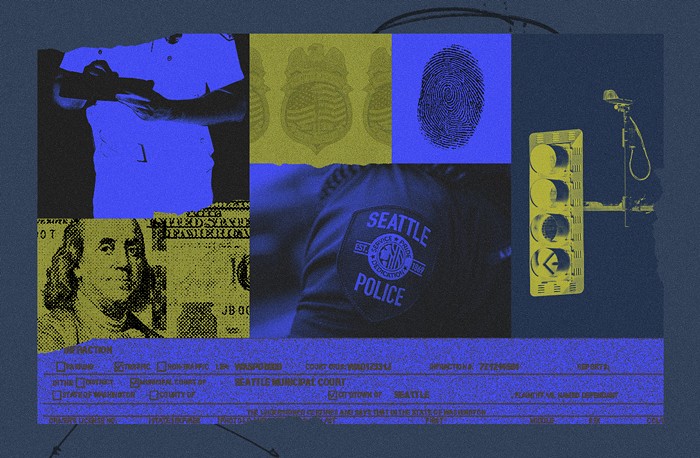
Last year, Seattle police were strongly criticized for the indiscriminate use of dozens of blast balls—small grenades that explode and emit tear gas—on May Day protesters. The blast balls injured a bystander named Jerry Savage, a Seattle Times reporter, and two street medics who are now suing the department. One man found an unexploded blast ball in the gutter.
The Office of Professional Accountability (OPA), the city's in-house watchdog, found in an investigation that police had improperly used the weapons by throwing them over people's heads and into the middle of crowds—but the OPA didn't hold any individual officers responsible for misconduct.
On Friday, I asked Sergeant Sean Whitcomb, the department's longtime head spokesperson, whether the SPD has learned any lessons or will be doing anything differently with blast balls during tomorrow's May Day protests. He evaded the question and talked instead about the department's existing training and use-of-force policies.
When I mentioned that one of the blast balls injured a Seattle Times reporter last year, Whitcomb stopped me and disagreed:
One of them burned a Seattle Times reporter's foot last year.
Did it?
Yes.
Are we sure about that? Because I heard back and forth that that may not have been a blast ball, but rather a firework.
There's a video of a blast ball going off right next to her foot.
Not a homemade firework?
Not a homemade firework.
Because I thought that went to OPA and it was not determined to be a blast ball. Maybe you should call Pierce [Murphy] on that. I remember that narrative distinctly. And I had heard things contrary to that since then.
Paige Cornwell, the Times reporter who covered May Day last year, went to the hospital for burn treatment later that day. "I haven't heard from the police department regarding any investigation," she said.
Cornwell never filed a complaint; the OPA never investigated her specific case. OPA Director Pierce Murphy told me Whitcomb is mistaken, and referred me to this passage of his report (PDF) on May Day 2015: "Some of the reported injuries, especially those involving burns and/or ankle and calf injuries, may have been the result of blastballs detonating in close proximity."
Murphy did, however, review the video above during his investigation. "It has characteristics of being a blast ball," he said, cautioning that he couldn't say for sure what it was. "There are two detonations. There's the visible detonation that you can see on the ground in front of her. That would be consistent with a blast ball."
The lack of accountability here is mind-blowing. To review: OPA does an after-action report on May Day and declines to hold specific officers responsible for anything. But the agency indicates that blast balls were used inappropriately and that they caused injuries.
After the 2015 May Day fracas, police chief Kathleen O'Toole asks an outside group—the Center for Policing Equity—to conduct a review of how Seattle police respond to protests. The group hand-picks which protesters it surveys in the fall. On Friday, the department couldn't offer any timeline for the report's release. And Murphy said the department had not provided him a final response to his December letter raising concerns about last year's May Day tactics, after the chief promised to study and consider his findings. "I wouldn't say I'm satisfied or dissatisfied," he said, with how the department has responded to his investigation. "I'm waiting."
Meanwhile, the public face of the SPD wrongly believes the OPA exonerated his department in one of the key examples of a blast ball injuring an innocent bystander. He tries to blame the injury on nefarious demonstrators throwing homemade fireworks instead.
Happy May Day, everyone.
This post has been updated since its original publication.


















